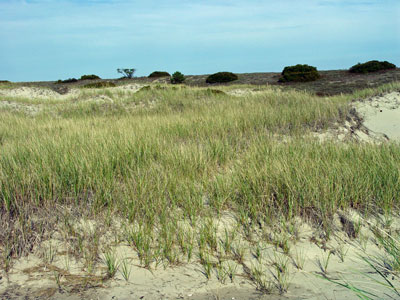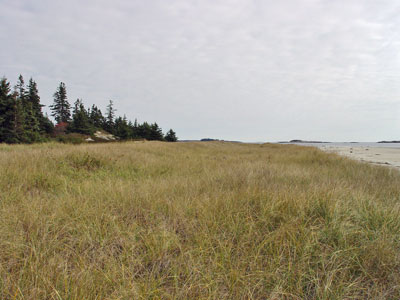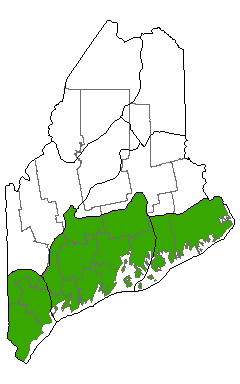DACF Home → Bureaus & Programs → Maine Natural Areas Program → Communities, Plants, and Animals → Natural Community Fact Sheets → Dune Grassland
Printer Friendly Fact Sheet - 700 KB pdf (Get a free copy of Adobe Acrobat Reader)
Dune Grassland
Scientific Name: Dune Grassland; State Rank: S2

- Community Description
- Soil and Site Characteristics
- Diagnostics
- Similar Types
- Conservation, Wildlife and Management Considerations
- Distribution
- Characteristic Plants
- Associated Rare Plants
- Associated Rare Animals
- Examples on Conservation Lands You Can Visit
Community Description: These sand dunes are strongly dominated by beach grass, with patches of beach-pea, red raspberry, bristly gooseberry, or poison ivy. In depressions or blowouts, grass cover is replaced by a mat of beach heather, golden heather, little bluestem, and pinweed, punctuated by tufts of reindeer lichens. Beach grass has stout rhizomes that allow it to colonize new places in its shifting substrate. Downeast of Acadia National Park, beach grass may be replaced by the ecologically and morphologically similar Virginia wild rye. Back to top.
Soil and Site Characteristics: Sites occur on coastal sand dunes between the high tide line and back dune marshes abutting uplands; this type is best expressed along the southwest coast. Back to top.

Diagnostics: Grass cover of beach grass or Virginia wild rye, which may include pockets of dwarf shrub - herb vegetation, characterizes these coastal dunes. Back to top.
Similar Types: Rose Maritime Shrublands can occur with these dune grasslands, but are dominated by shrubs rather than herbs. Coastal Beaches often occur on the shoreward margin of Dune Grasslands and are dominated by forbs rather than grasses. Back to top.
Conservation, Wildlife and Management Considerations: Beach dune systems along Maine's southwest coast have been reduced in extent by development. The intact dune systems that remain are almost all in public or private conservation ownership. Even with this protection, however, dunes are subject to degradation from uncontrolled recreational use. Even light foot traffic can initiate blowouts that will persist for years. Attempts over the last decade to educate people about the importance of staying out of dune areas are helping, but constant vigilance will be required in the face of increasing beach use. The prospect of sea level rise may also put these systems at greater risk.
Dune grasslands and adjacent upper beaches are critical breeding habitat for two species of endangered shorebirds: least terns and piping plovers. Nesting habitat for these birds has been reduced by human use of beaches, and the known nesting sites in Maine are carefully monitored. Other ground nesting bird species that may utilize these habitats include laughing gulls and short-eared owls. Back to top.
Distribution: Mostly southwest of Merrymeeting Bay, occasionally eastward; extends southward along the Atlantic Coast to New Jersey. Landscape Pattern: Small Patch, linear. Back to top.


Characteristic Plants: These plants are frequently found in this community type. Those with an asterisk are often diagnostic of this community.
- Sapling/shrub
- Bristly gooseberry
- Red raspberry
- Dwarf Shrub
- Beach heather*
- Herb
- Beach grass*
- Beach-pea*
- Jointweed
- Little bluestem*
- Pinweed*
- Virginia wild rye*
- Laughing gull
- Least tern
- Piping plover
- Short-eared owl
Examples on Conservation Lands You Can Visit
| Example | County |
|---|---|
| Crescent Beach State Park | Cumberland Co. |
| Popham Beach State Park | Sagadahoc Co. |
| Rachel Carson National Wildlife Refuge | York Co. |
| Reid Beach, Reid State Park | Sagadahoc Co. |
| Seawall Beach, Morse Mountain Preserve | Sagadahoc Co. |